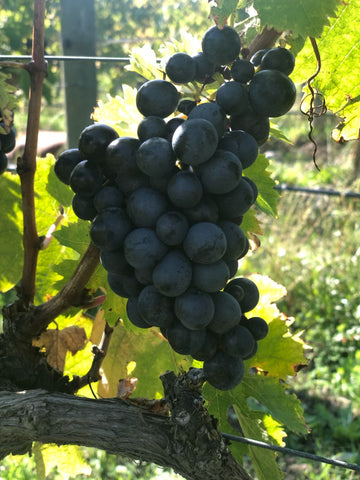
25-year old Montepulciano vine 12/04/21
Do Italian varieties from Marlborough equal to their native ‘cousins’?
“Many Italian grapes grow well on slopes and hillsides, and in volcanic or alluvial soils - all of which New Zealand has. Throw in a moderate climate and amazing sunshine, and you get these wines with great purity of fruit flavours.” Fongyee Walker MW.
Montepulciano d’Abruzzo does not have the star power of many other Italian wines and regions, but it has enough going for it to warrant a second look…
Montepulciano is a vigorous red grape variety, indigenous to most likely the Abruzzo region in central Italy (along the 42nd parallel north) and the second most widely planted Italian grape variety (about 30,000 ha[1]).
The thick-skinned grape variety produces deeply coloured wines with robust tannins but because of the wide diffusion of Montepulciano grapes, the quality levels of the wines vary considerably. Montepulciano di Abruzzo can be a great wine but more often comes from high, commercial yields as the region is steeped in large-scaled, overcropped, over-oaked and rustic wines producing cheap and forgettable wine.
When tamed by hard vineyard work and low yields, the true essence of this magnificent grape variety is emerging for long-lived, intense, spicy wines with an impressive soft tannin structure. Ian D’Agata put it in his “Native Wine Grapes of Italy”, Montepulciano is thought to be “generally a workhorse grape,” though he also suggested it had “thoroughbred potential” proven by two of the most esteemed Montepulciano D’Abruzzo producers, Valentini (Average price NZ$423 on Wine searcher) and Emidio Pepe (average price NZ$244).
Hans Herzog pioneered Montepulciano in Marlborough (41.5th parallel south) back in 1996 knowing that if he gets that late ripening variety physiologically mature, he would hold the ‘green card’ to plant many other late ripening grape varieties. 1998 was the first vintage and an immediate success achieving a cult following. It was soon after named as one of the 50 best new world grape varieties by Jancis Robinson and made its entrance to the book “1001 wines you must try before you die”. “Wine Grapes” authored by Robinson, Harding, Vouillamoz writes about Montepulciano “beside Italy, it is also grown in California, Australia and New Zealand, notably from Hans Herzog.
What Hans has in common with top Italian wine producers, is a superior microclimate and terroir, the philosophy for higher density planting and lower yields for complex, powerful and long-lived wines. Like them, he has excellent vinivication knowledge from over 50 vintages and an artisanal approach to wine growing. Like all top producers he is only using his own grapes to have total control over the quality of the fruit and often insists that natural and non-interventionist winemaking is key.
Marlborough has an oceanic climate, also known as a maritime climate and is classified as warm and temperate climate. It hasn’t seen the heat-waves triggered by climate-change, a serious concern for Italian winegrowers and the need for cooler, higher elevation vineyard. Marlborough is also one of the driest regions in New Zealand ideal for organic winegrowing. Its significantly cool nights make for an enviable long ripening period. This allows the fruit to ripen slowly, ensuring complexity and high fruit
intensity, flattering not only the Italian grape varieties but making Marlborough one of the world’s most unique and best climates to grow any wines. It outshines Abruzzo (annual sunshine hours average 2261 h) with its 40-year average of over 2,500 sunshine hour per year! This is amplified by our vineyard’s microclimate owing to its location on the banks of a mighty river and its unique terroir of well-drained sandy and gravelly alluvial soils. The famous dry and warm autumns are of huge advantage when it comes to harvest, as it allows us to wait until the grapes are physiologically ripe. There is little vintage variation in terms of quality for our terroir-driven wines.
Montepulciano is one of our favourite grapes to handpick and a beautiful sight to see them hanging so majestically in the vineyard. Medium sized compact bunches (when spur pruned and on a slow growing rootstock like 101-14), with medium sized grapes, intense colour and thick skin (providing more colour, texture and protection against diseases). It is the last variety we pick, demanding a long growing season and perfect Indian summer.
Winemaking is totally natural. Grapes are destemmed and protected and cooled with dry ice to be left to cold soak for 5 to 6 days. Temperature controlled long indigenous wild fermentation of 3 weeks and post-fermentation macerations encourage a slow, soft extraction of colour and flavour aiding to the richness and longevity of the wine. A traditional manual bag press ensures a gentle handling of the grape must. No sulphur is applied in this process. From there it is transferred into carefully chosen new and a few years old French oak barriques to mature for up to 30 months. We always look for purity and varietal character with oak that accentuates but never masked the beautiful fruit aromas. There is never any fining or filtration and only minimum effective Sulphur to protect the wines on its worldwide travels.
[1] Interesting comparison to NZ where the most planted grape variety Sauvignon Blanc accumulates to 25,160 ha)
Latest Montepulciano release:
Montepulciano 2016
“Made from low-yielding vines that achieve impressive concentration of mellow plum, dark berry, mocha, coffee, vanilla, anise and liquorice flavours. This is one of the best New Zealand-grown examples of Montepulciano that I have tasted.”
Bob Campbell
Montepulciano grape 25/4/21
Hans plunging Montepulciano, April 21


